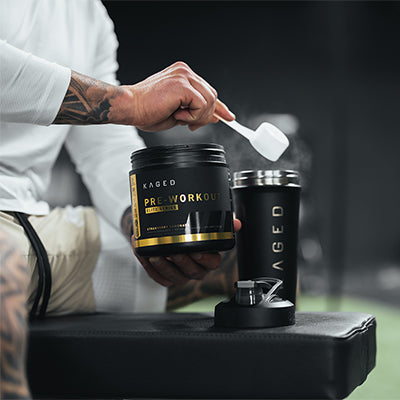When it comes to building impressive muscle mass, there should be one must-do on every athlete’s agenda: shock your system.
Simply put, if you hit the gym on a weekly basis and do similar training styles, similar exercises, and a similar rep and set range, you’re headed straight for a plateau. Your body will adjust and adapt to what you’re doing and when it does, you can kiss your progress goodbye.
The good news is that with a few proven techniques, you can shock your muscles and force them to respond by getting stronger and larger, provided you have proper nutrition in place.
Need some suggestions on new techniques? No problem. Here are five great techniques to get your progress moving in the right direction again.

1) Pre-Fatigue Sets
Pre-fatigue sets are a great way to bring up a lagging muscle group. For this principle to work, you first need to identify the muscle you’re targeting and then figure out which muscle groups may be assisting that muscle in the exercises you are doing.
For example, if you’re using a chest press to work your pecs, you’re also working the shoulders and the triceps. If your triceps happen to be a strong muscle group, they may actually be taking the stress off your chest. In this situation, your chest won’t get as strong as you had hoped. Instead, the triceps will continue to develop and overshadow other muscle groups.
This is where pre-fatigue sets come in. Use these sets to tire out your triceps first so when you move onto the bench press, they aren’t assisting your chest nearly as much. Now, more of the stress will be placed on the chest, yielding greater improvements in strength – and hopefully size. Be aware that you may have to decrease the weight you lift on your bench press as your supporting muscle group is fatigued at this point, and you don’t want to run the risk of injury.
When you go back to doing straight sets after using pre-fatigue sets, you should notice that you can now hit the PRs you were working towards.
Example: Tricep Extensions Before Bench Press
In this example, you may do a set of tricep extensions, and superset that with bench press.
Take note that pre-fatigue sets are quite intense. You’ll likely find yourself more exhausted after doing them so they shouldn’t be done every training session, and you shouldn’t do more than one or two exercises in this manner per session.
2) Rest Pause Sets
Another great way to stimulate more intensity with your workout session and provoke growth is rest pause sets. This is a good technique to use when lifting a heavy weight and wanting to achieve more total time under tension.
To do this, pick a weight you can lift about five times. Now, perform two to three reps with that weight. Pause at the bottom of the lift for 15 seconds or so. Now perform two to three more reps. Pause once again, then perform another two to three reps. You can do three to four pauses per set, allowing you to reach more total reps than you would have done had you performed a straight set of five reps. Over time, this helps boost the total volume of your workout and also increases the total amount of weight the muscles are subjected to.
3) Drop Sets
The next great muscle shocking technique to use is a drop set. While pre-fatigue sets focus on fatiguing a supporting muscle, drop sets focus on fatiguing the main muscle you’re targeting in your training session.
This technique is straightforward. Start by performing one set at your desired weight and once you hit fatigue, decrease (or drop) the weight and perform the second set. Once that set is finished, you can drop the weight a third time if you wish and perform as many reps to fatigue as possible.
How large of a drop you take with each successive set is up to you, but usually, you’ll drop by around 10-20 pounds for compound exercises, and 5-10 pounds for isolation exercises.
With each drop you do, pay special attention to your form. It’s easy to let your form slip as fatigue sets in. This technique will train your body to push through fatigue and you should find that over time, your strength will have improved when you return to using straight sets again.

4) Negatives (Or "Eccentrics")
Negatives are another great way to stimulate peak muscle growth and strength development. The negative portion of your exercise is the eccentric phase of the movement pattern, which is where the muscle fibers are lengthening, usually moving back to your starting position. For example, the downward portion of a bicep curl is the negative component of the exercise.
You’ll tend to be stronger on the negative phase of the exercise (as opposed to the concentric phase, where the muscle fibers shorten and contract), so you can lift more weight. However, traditional sets don’t challenge you in this phase as you’re limited by how much weight you can lift in the concentric phase.
The solution? Negatives.
Get a spotter to help you with this exercise. Use a weight that’s around 10% heavier than what you normally lift and have your spotter help you get the weight up. Once up, slowly focus on the eccentric phase, taking 4-5 seconds to execute that portion of the movement. Once at the bottom of the lift, have the spotter help you through the concentric phase again and repeat the slow negative. Use this technique on two to four sets of one exercise per session and prepare to see greater results because of it.
Consider yourself warned: expect to be sore after this type of training. It has the potential to evoke great muscle damage, so stretching your muscles after this technique is key.
Negatives are using in many situations. For example, if you struggle to do a full set up pull-ups, jumping up to the top and performing the negative slowly down is a great way to build strength in your lats.
5) 100 Rep Sets
Finally, if you're ready for one of the most intense muscle-building strategies available, try the 100 rep set. This muscle shocking technique is excellent for building endurance and will also help promote great fat burning.
For this technique, select a relatively light weight that you feel you could do for around 50-60 reps total. Begin by doing as many reps as you can until you reach a point of fatigue. Rest briefly until you can perform more reps. Again, complete as many reps as you can before taking another short break. Continue this pattern, taking as few rest breaks as possible, and also keeping rest breaks as short as possible, until you have finished 100 reps. You will only do one set of this technique.
Note that this technique is incredibly intense and exhausting, so don’t expect to do it more than once every week or two. Also, try to avoid using it on exercises that require more coordination such as squats. Your risk of injury will be considerably higher on such exercises if your form gets sloppy. Do your best however, regardless of which exercise you’re doing, to sustain proper form. That is what will help you achieve greater strength and muscle building results.
Next time you hit the gym and find yourself doing the same sets and reps, try any one of these muscle-shocking techniques. Just don’t try them all in the same day!

More on Muscle Building
The bottom line is that if you want to build muscle, first and foremost you have to stay consistent with your training. In this article we cover 12 tips to keep you on track.
You also can't neglect your nutrition. Check out this article with 5 unconventional foods to help you get ripped.




























